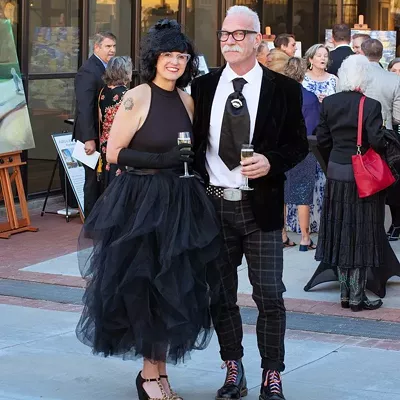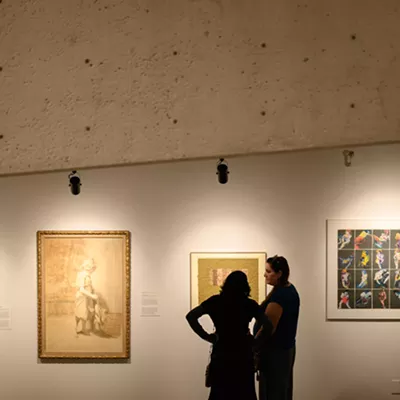Merry Christmas! Happy Hanukkah! Good Kwanzaa! Sweet Solstice!
Whatever holiday you favor, make sure that when you sit down to your feast, you give thanks to the farmworkers who provided the food on your groaning table.
A big, exuberant mixed-media painting by New Mexico artist Erin Currier at the University of Arizona Museum of Art does exactly that. "The Harvesters" pictures three smiling, fresh-faced farmworkers, one woman and two men, each carrying a bushel of gleaming red tomatoes. The sun smiles sweetly down on the enterprise.
The beautiful work, in Currier's trademark mix of acrylic paint and found papers collaged onto wood, celebrates the unsung, underpaid workers who pick the fruits and vegetables that Americans eat. The United Fresh Produce Association puts the number of produce farmworkers in the U.S. at 1.5 million to 2 million, and the percentage of those who are undocumented at anywhere from 50 to 70 percent. That makes up to a million laborers, working long days plucking tomatoes in Florida, slicing lettuce in the fields of Arizona, living in fear of deportation.
In fact, Currier's "Harvesters," cheerful though it seems, has a dark context of suffering. The three workers she depicts are the founders of the Coalition of Immokalee Workers, a Florida group that has fought for better wages and human rights for migrant tomato pickers. The coalition has had some success, notably in uncovering slavery (yes, slavery) in some of the remote farms and in persuading national fast food companies and groceries to pay more for the tomatoes they buy.
And the rest of La Frontera, Currier's solo show of a dozen paintings, is a fairly grim accounting of conditions for immigrants and refugees and the impoverished worldwide, from a desperate shoeshine man in Latin America to kids behind bars in the Congo. Cutting close to home, she pairs a painting of stranded African refugees in the Mediterranean island of Lampedusa with a dispiriting look at deportees from the U.S. trapped in Nogales, Sonora. All of their faces bear the same look of despair.
One painting is joyful. "American Women (Dismantling the Border)" shows indigenous women of the Americas reclaiming their ancestral lands, tearing down the wall, piece by piece and pole by pole.
An all-photography show at Etherton Gallery is showing off three artists with Tucson ties: renowned "New Topographics" landscape photographer Frank Gohlke, a UA Regents Professor and head of the UA photography program; Stephen Strom, an astronomer turned photographer; and the late Todd Walker, a longtime and much-loved UA art professor whose adventurous experiments foreshadowed the digital revolution.
Walker (1917-1998) gets a major exhibition of 85 works. Timed to mark what would have been his 100th birthday, the retrospective reveals just how far ahead of his time Walker was. Experimenting with multiple techniques, he created colorful, hallucinogenic figures and landscapes that challenged the dogma of the pristine print. At the same time, he rediscovered and reinterpreted antique photo techniques from the 19th century.
"He was a real innovator," says gallery owner Terry Etherton. "The guy was brilliant. He was an artist all day, every day."
Working in the 1960s and 1970s, long before the digital explosion, Walker practiced pioneering forms of both photography and printmaking, often combining the genres in a single work.
All his pieces started as black-and-white photographs, Etherton says, and the vivid colors on top were "all synthetic." To layer the colors over the photo, Walker used a host of processes, from transfer dyes to silkscreen to lithography to gum bichromate to the van dyke print. He even made digital images with early Apple computers.
Nowadays, ink-jet printing of digital photos on paper is commonplace, but in the 80s, when Walker was layering ink onto paper, curators and art fans "didn't understand it," Etherton says. "Now we're totally used to it."
His exhibition is drawn entirely from his archive, still maintained in the studio of his Tucson house, and managed by his daughter, Melanie Walker, a Colorado photographer. Walker was never a self-promoter, Etherton says, preferring to devote himself to his art and his students. The gallerist is hoping Walker at 100 will spark a renewed interest in his work and will travel elsewhere in the country.
Gohlke, a UA professor for the last 11 years, is showing never-before-seen work that bolsters his reputation for capturing the "landscape of everyday life." Dating from 1971-1972, the black-and- white series, Speeding Trucks and Other Follies, pictures boxy big rigs, in close-up and at a distance, barreling through uninhabited roadways. Showing at Etherton for the first time, Gohlke also offers a small sampling of his best-known images: Midwestern grain elevators rendered in austere geometries.
Strom, a retired astronomer who once worked at Kitt Peak and at the National Optical Astronomy Observatory on the UA campus, has an up-to-the minute show of photos of Bears Ears National Monument in Utah. President Trump recently declared that he will cut this monument by an astonishing 85 percent. Strom's long-view color images capture the cherished wild space, which is graced by 100,000 archaeological sites.











